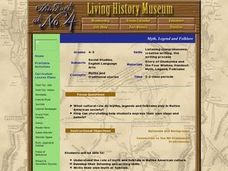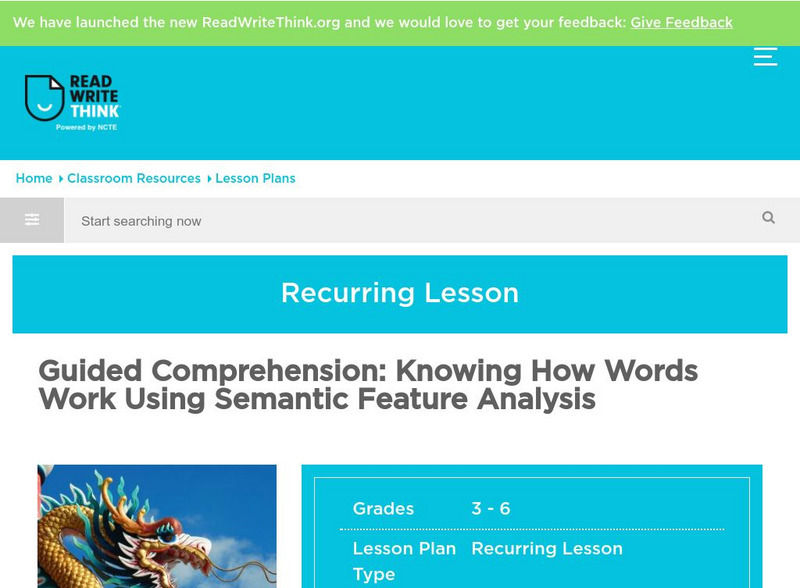Curated OER
Those Fabulous Fables
A video leads off this activity on fables, introducing the class to this important form of traditional storytelling. The group defines fable and hears an explanation of the origin of this type of folk tale. They summarize the story they...
Pearson
Catching the Sun: Tales from Asia
Explore the folklore of Asia and the South Pacific with this language arts lesson series. Complementing a reading of Catching the Sun: Tales from Asia by Jan M. Mike, this resource supports learners with understanding cause and...
Curated OER
Fables and Trickster Tales Around the World
Students analyze fables and trickster tales from various cultural traditions. In this fable analysis instructional activity, students identify the elements of fables and trickster stories. Students read Aesop's fables and Ananse...
Curated OER
Myth, Legend and Folklore
Learners examine the role of myths and folklore in the Native American culture. They listen to examples of oral history and write their own. They share their story with the class.
Curated OER
Technology-commected Folklife Lesson Plan: Fables
Students discuss ways the stories were alike and different. The teacher demonstrate how to draw a Venn diagram using Microsoft Word. They label the two circles and enter the likenesses and differences on the diagram.
Montana State University
One Mountain, Many Cultures
Americans may think of Mount Everest as a region dedicated to adventurous hikers, but many cultures have flourished there! Learners read informative books, watch videos, participate in classroom discussion, analyze folk tales, and...
Curated OER
Rhyming Words
In this rhyming words worksheet, 4th graders complete activities such as circling rhyming words, writing rhyming words, and more. Students complete 6 activities.
Curated OER
Tales From Around the World
Young scholars read stories. For this culture lesson, students read stories from different regions around the world. Young scholars look for each region on the map and listen for interesting cultural details in the story. Students then...
Pennsylvania Department of Education
Comparing Key Ideas and Details in Fiction and Nonfiction
Learners recognize the differences between fiction and nonfiction texts. For this genre study lesson, students discuss what nonfiction means and write the definition. Learners listen to a read aloud and vote whether the text is fiction...
Curated OER
Using Graphic Organizers to Generate Genre Definitions
Pupils listen to or read a variety of stories and then work individually or in groups to complete graphic organizers that will help them focus on elements within different types of stories. They write definitions for a variety of story...
Curated OER
Alliteration
In this alliteration worksheet, 4th graders write alliterations with their first names, find rhyming patterns in poems, and more. Students complete 4 activities.
Curated OER
There Was an Old Lady. . .
Students alter a familiar short poem or song with synonyms and antonyms. In this synonym and antonym lesson, students replace the synonyms or antonyms in the text and discuss the changes in meaning. Students share their words.
Curated OER
An Unfinished Tale...
Challenge your writers to compose a proper ending for the short story "The Talisman." Class members start out by either listening to or reading the first nine paragraphs of the story. The rest is up to them! Encourage kids to resolve the...
Curated OER
Touring the World With Tomie dePaola
Learners listen aloud to books by Tomie dePaola. They utilize the Internet to study the geography and culture of the places the they read about in Tomie dePaola's books. They answer questions about Norway through an Internet treasure hunt.
Curated OER
Metaphors
In this metaphor worksheet, learners make a "word card" with the word metaphor for their vocabulary bank, then determine whether statement from The Dragonslayer are similes or metaphors,
Curated OER
Kissing Coyotes
Fourth graders are read the book "Kissing Coyotes". During the story, they make predictions about what they believe might happen next. After the story, they create their own story using their imagination and draw illustrations.
ReadWriteThink
Read Write Think: Guided Comprehension: Semantic Analysis
Lesson introduces students to comprehension of knowing how words work. Students learn semantic feature analysis and examine folktales, myths, and fables using this analysis to better understand these terms and texts.
















